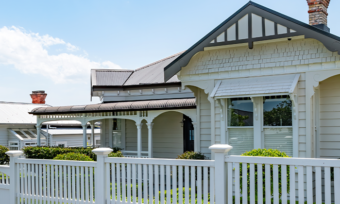What is home and contents insurance?
Home and contents insurance offers financial protection for your home and belongings against insured events such as fires, storms, floods and theft.
Home insurance (sometimes referred to as building insurance) covers the house that you live in and outbuildings such as garages and sheds. It also typically covers permanent fixtures on your property like fences, swimming pools and built-in air conditioners and dishwashers.
Contents insurance covers possessions within the house, such as furniture, electrical appliances and clothes. In some cases, it may also provide cover for portable items you take with you when you leave home, such as jewellery, although this may come at an additional cost (depending on your policy).
→Related article: Home & Contents Insurance & Jewellery: What You Need to Know
If you’re a homeowner, you may decide to have either home insurance, contents insurance, or a combination of both home and contents insurance. If you have a home loan, it may even be a condition of your loan that you have home insurance. If you’re a renter, you’ll generally only need to consider contents insurance, as your landlord should have insurance to cover the property you’re living in.
→Related article: How Does Renters Insurance Work in NZ?
Home insurance can come in the form of sum-insured cover or total replacement cover. Sum-insured cover involves estimating how much it would cost to rebuild your home if it was destroyed. The cost of the policy premiums and the payout made in the event of a successful claim would be based on that amount. This is the more commonly offered type of cover. Total replacement insurance covers you for the total amount it would cost to repair or rebuild your home.
How much does home and contents insurance cost?
Factors that increase the risk of damage or destruction to your home and contents – and therefore increase the likelihood of a payout – will typically increase the cost of your home insurance. The level of cover you take out also generally affects how much you pay for it.
Here’s a roundup of some of the variables that insurers tend to look at when determining the the regular cost of a home insurance policy – your premium:
- Whether you are covering your home, contents or both
- How much you choose to cover your home and contents for (the sum insured or total replacement cover)
- If you decide to add any optional types of cover, such as accidental damage, cover for portable items and motor burnout
- How much excess you choose (this is the amount of money you pay if you need to make a claim)
- Your claims history
- Where you live (for example, if you live in an area that is prone to natural disasters or has a high crime rate)
- Characteristics of your home
- The security features you have
Home and contents insurance costs
To give you an idea of what’s on offer from home and contents insurers, Canstar has compiled a list of the top rated home and contents providers in New Zealand. Check out how you can save on home and contents insurance costs by clicking on the button below.
Compare home and contents insurance with Canstar
How can you lower your home insurance costs?
Many insurers offer discounts for buying policies online and buying home and contents insurance together. Consider checking with your insurer whether it’s possible to apply multiple discounts to your premium if you are eligible for an online discount as well as a home and contents discount, for example.
→Related article: 5 Ways To Save On Your Home Insurance
You may also be able to lower your home insurance premium by increasing your excess. Your excess is the amount you pay towards each insurance claim you make on your policy. Generally, the higher the excess you agree to pay, the lower your premium will be. If you’re considering increasing your excess, make sure that you can afford to pay this amount in the event you need to make a claim.
Some insurers may also lower your premiums if you install safety and security features such as security screens and alarms. Insurers may also charge lower premiums if you pay for your insurance annually rather than in more frequent instalments.
If you’re considering taking out a home and contents insurance policy, it can also be a good idea to shop around for better value.
Is home and contents insurance tax-deductible if I work from home?
According to Business.Govt.NZ, if you work from home, you can claim claim business expenses (including home and contents insurance) to reduce your tax bill. However, there are strict limits on the amount you can claim for your home office and, of course, you’ll need copies of all your bills and receipts.
How do I pay for home insurance?
Premiums can be paid annually or in regular instalments, for example in monthly or fortnightly payments. Some insurers charge higher overall premiums and fees if you choose to pay by instalments.
You might like to set up a direct debit to help make sure you pay every instalment on time. If you don’t keep up with your repayments, this could void or cancel your home insurance. For example, if you don’t pay a monthly premium instalment within 14 days after the deadline, some insurers say they may refuse to pay a claim. In addition, your insurance provider may cancel your policy altogether if an instalment is a month or more overdue.
How to buy home insurance?
Each insurer will have its own process for setting up home and contents insurance, but generally it will involve you specifying what you want covered (home, contents or both), the value of your coverage (your chosen sum insured or total replacement cost), what extra events you wish to cover for an extra premium (for example, accidental damage, motor burnout and personal effects like jewellery and cameras) and how much excess you are willing to pay. You may also be asked to answer questions about your home and its occupants.
If you decide to switch home insurance, you’ll go through much the same process. If you switch to a cheaper policy, make sure you check what the level of cover is.
How do I make a home insurance claim?
You can usually make a claim over the phone or online. It is usually best to tell your insurer of any damage or destruction immediately, and to provide as many details as possible of the incident and how it happened.
You will often need to provide proof of the damage, so take as many photos as possible of any damage to your property or belongings. It’s also worth taking photos of your property or belongings when you first take out your policy, to help with proof of damage down the track. Some insurance companies have mobile apps so that you can upload the photos directly from your smartphone and upload your claim straight away using the app.
You may also need to provide evidence of ownership and value of any particular items that you are making a claim on. For example, this could include receipts, valuations, credit card statements and photos.
→Related article: What Can Invalidate Home & Contents Insurance?
If you’re considering taking out a home and contents insurance policy, you can compare the features of a range of policies using Canstar.
Compare home and contents insurance with Canstar
About the reviewer of this page
This report was reviewed by Canstar Content Producer, Caitlin Bingham. Caitlin is an experienced writer whose passion for creativity led her to study communication and journalism. She began her career freelancing as a content writer, before joining the Canstar team.
Enjoy reading this article?
You can like us on Facebook and get social, or sign up to receive more news like this straight to your inbox.
By subscribing you agree to the Canstar Privacy Policy











Share this article